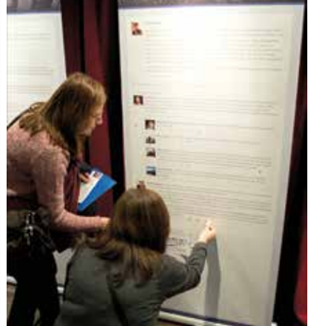
We Millennials and that Strange Italian Priest
The American "selfie generation" is dismissed by some as lazy, vain, and indecisive. In an exhibit, some of them tried to speak of their experience in the light of the encounter with Fr. Giussani.The Millennial generation reaches out its arm, offers the cell phone camera its best profile, and then admires the shot: “I’m exceptional,” says the face immortalized in the selfie, a photograph in which the subject and the object are one. Popular culture has tried to grasp the characteristics of these kids: lazy, creative, vain, indecisive, impervious to the old ideologies, obsessed with the sparkling of their own “I,” and at the same time fragile victims of the most varied anxieties. They are alternately described as either the lost generation or the one with the greatest potential; they are said to be composed of restless optimists who think their best days are yet to come, but are certain that salvation will not come from institutions, the government, a career, or the other idols of their parents. From whence, then? The selfie is an initial clue. It may be narcissistic, but it is also a sign, an unrepeatable face that deserves to be captured and shared. The selfie, too, is a “crazed truth,” as Chesterton would say. “I am exceptional” is the title that a group of 75 young Americans chose for an exhibit that recounts the “Millennial experience”–which is, after all, the human experience, with its desire for fulfilment, filtered through the particular sensibility of a generation that everyone tries to archive under this label. Last summer, when José Medina, the responsible for CL in the United States, proposed that all of the Millennials of the CL communities across the country present an exhibit together at the New York Encounter, his idea was to read Fr. Giussani through the eyes of a generation that had not met him. Martina from Nebraska, one of the curators of the exhibit, explains, “Everything changed during one of the first encounters, when I had the perception that I was not interested in communicating to others a synthesis of the thought of Giussani: I wanted to do an exhibit on myself, on my human experience in the light of my encounter with Fr. Giussani.”
Infallible Instrument
Slowly the emphasis shifted from the doctrine of life to the sociology of experience. It was not a matter of putting up panels about a theoretical itinerary, but of bumping up against the charism, (re-) encountering it, and allowing oneself be transformed. Six working groups were formed to confront the texts, first of all with an analytical approach. Some looked more deeply at the religious sense, others at the dynamic of the revelation of Christ, while still others at the hypothesis of a presence that remains, the Church, always with the eyes and heart striving to intercept the contemporaneousness of those words. Thus began an adventure made up of readings and hours and hours of driving across America, all to become increasingly familiar with one’s humanity. The second phase of work took a form more like School of Community, with constant comparison between the texts and experience. “We re-proposed the itinerary of Giussani, but through our life,” says Carolina Brito, a teacher in Boston, underlining perhaps the most original aspect of the exhibit: those who created it are not just the guides for the itinerary, but are part of the content of the exhibit. Every guided tour is implicitly a personal story. The panels have excerpts of dialogues on the Facebook notice board (where else?) between the kids and Giussani, Tarkovsky, and Alicia Keys. The ugly duckling–chosen as a metaphor for a generation–intersects with the editorials of young opinion makers. There are suggestions about the desire for fulfilment that hides in the “quarter-life crisis,” and the idea that the human person has an infallible instrument for judging, the heart.
One opens to the dizzying possibility that the response to the heart that reaches out has happened in the encounter with the human person, and has even become a companionship. There are John and Andrew, Mary Magdalene, a modern Simon (Peter, that is), his rough face of a minor with a cigarette hanging from his lips. Looking into the eyes of these kids, you sense that in these months of work something mysterious and irreducible has happened, the irruption of a presence that changes life.
Jonathan Ghalhy, from Colorado, talks about “how it was impossible to separate the content of the exhibit from their lives,” and Beth Nelson from Minnesota says that as she finished giving each exhibit tour she would burst into tears. “It may seem pathetic, but it indicated that I was in a ‘danger zone,’ that is, I was verifying. Explaining the exhibit is a verification of the exhibit itself.” An experience, as Fr. Giussani proposed.